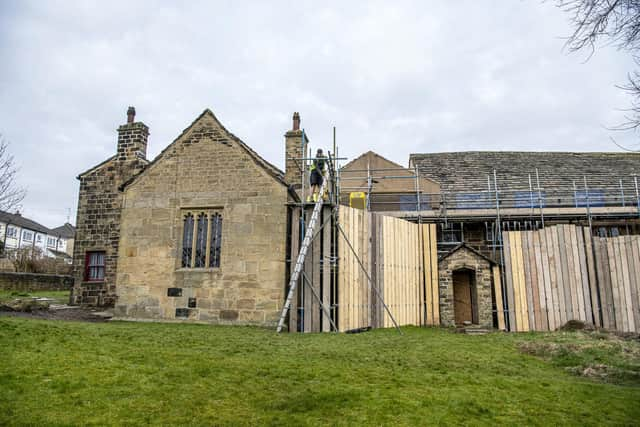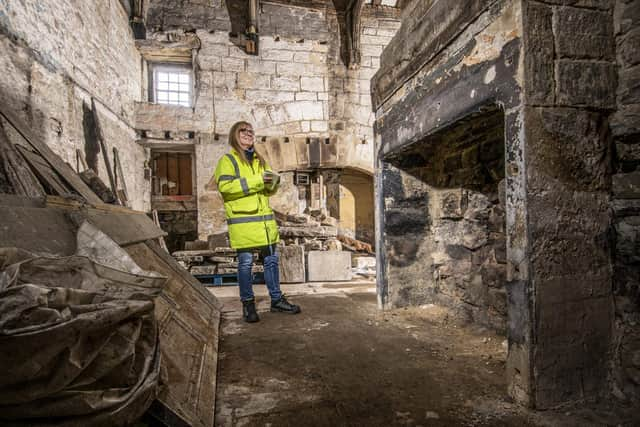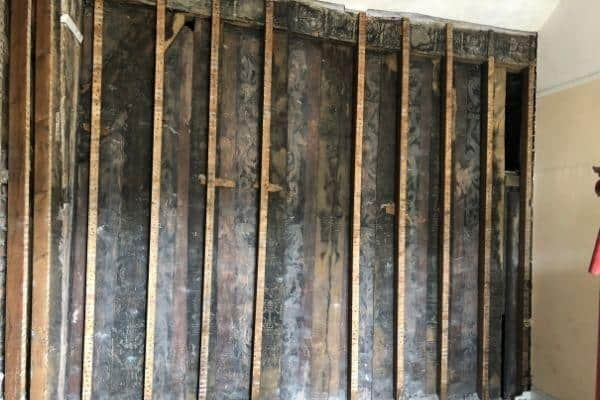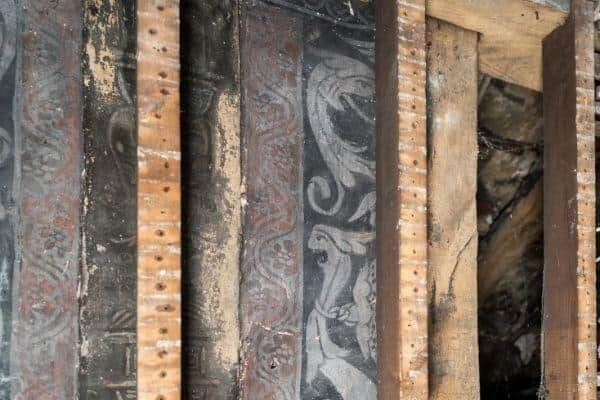Calverley Old Hall: Historians make 'once in a lifetime' discovery as they find entire lost room of Tudor paintings in Yorkshire medieval hall
Calverley Old Hall, between Leeds and Bradford, is currently subject to a major repair and renovation programme funded by the Landmark Trust, who have owned the building and run part of it as a holiday let since 1981.
The oldest parts of the hall date back to the 14th century but most of it is Tudor. It was the seat of the Calverley family for centuries until the 1750s, when they sold the estate and moved to Esholt Hall. Calverley Old Hall was then subdivided into cottages.


Advertisement
Hide AdAdvertisement
Hide AdAhead of the current restoration work, historians and conservation specialists were able to examine the fabric of the building and made an incredible discovery behind a 1930s fireplace.
The team were removing small areas of Victorian plasterwork to see whether the main joints of the hall's timber structure were still sound. The upper chamber of the parlour block where the find was made was described as 'unremarkable' and its walls had been painted peach in the 1970s.
Dr Anna Keay, who worked at the site, said: "An exposed area of timber seemed to have something on it; reddish, greenish, and blackish stains on the oak. We thought they could just be the streaks and smudges of mould and dirt and decay. It looked to be wishful thinking that this was anything of note. But just on the off chance, ever cautious, we decided to ask the conservators at Lincoln Conservation to have a look.
"Then came the thunderbolts. First, the Lincoln team removed the plaster in a further five small areas and revealed what we had not dared to hope: wall paintings. Black and white and ochre and red, clear and unmistakable wall paintings. We were speechless. It was clear at once that these almost certainly dated to the Tudor period. But still we only had specks. Five vivid pieces from a jigsaw of 500, we knew where they went but had no idea of the picture they made.


Advertisement
Hide AdAdvertisement
Hide Ad"Later, the Lincoln team returned. Two days were allocated to them on site to remove the later plaster altogether and see how much remained beneath. I stopped in on the morning of day two, expecting them to have only just begun. When I walked up the stairs into the room I was simply overcome. The plaster had gone and there on all three walls before me was a revelation. Floor to ceiling, wall to wall, a complete, highly decorated Tudor chamber, stripped with black and red and white and ochre. Mythical creatures and twining vines, classical columns and roaring griffins.
"Wall paintings were prized in grand Tudor houses, and from time to time patches of them are revealed. But never in my own 27 years of working in historic buildings have I ever witnessed a discovery like this. Hidden panelling, yes, little snatches of decorative painting, once or twice. But an entire painted chamber absolutely lost to memory, a time machine to the age of the Reformation and the Virgin Queen, never.
"Lots of complex questions have now arisen. When exactly they were painted - according to our timber dating of the timber frame, it could be 1540s or perhaps more like 1580s - how best to preserve them, how to furnish and service a room with such spectacular surviving decoration. But their importance cannot be doubted. With them a slice of the lives of our ancestors has been restored to us, and nothing comes close to that."
The Landmark Trust now hopes to raise £94,000 to ensure the paintings can be preserved as part of the renovation project, which will see further areas of the historic site opened up. Many rooms had been closed off and abandoned for years. The plans include expanded accommodation for 10 guests in the holiday let as well as a new community space.


Advertisement
Hide AdAdvertisement
Hide AdA statement from the Trust said: "Though our let has thrived in one part of the hall since the 1980s, most of the rest has been standing weathertight but gutted and empty, cavernous medieval blocks quietly awaiting their next incarnation.
"Inevitably, focus has tended to fall upon the stunning great hall and earlier solar/hall block, but tucked behind the solar block is what today seems just a little cottage, its bedrooms plain, plastered rooms.
"And it is behind the 19th-century plaster in one of these rooms that we have made a truly astonishing discovery. We have found a complete scheme of mid-16th century wall paintings across three walls of the original chamber. This is in itself an important discovery: although most vernacular houses above even middling status had some kind of painted decoration on their walls from about 1570 to 1650, such survivals are very rare, especially in northern counties and especially covering entire walls.
"Even more exciting is that the Calverley scheme is so-called Grotesque work. It is a great deal more sophisticated than almost any other surviving domestic wall paintings in the country, and certainly than any known to date in Yorkshire.


Advertisement
Hide AdAdvertisement
Hide Ad"Suddenly, we are transported from a dusty, dilapidated building into the rich and cultured world of the Elizabethan Calverleys, a well-educated family keen to display their learning and wealth by demonstrating their appreciation of Renaissance culture. The Calverley paintings are very carefully planned, in a vertical design that uses the timber studwork as a framework. Teethed birds laugh in profile; the torsos of little men in triangular hats sit on vases or balustrades. When the fantastical figures and architectural elements are incorporated into dense vertical stacks as at Calverley Old hall, they’re known as ‘candelabra.’
"The whole chamber was probably originally covered in the scheme, a rich, dark, private space that must have been all the more impressive by candlelight.
"Such decoration became an integral part of the later Italian Renaissance. Later, in 18th-century Britain, such designs danced their way into the interiors of architect Robert Adam, newly returned from his own Grand Tour of Italy, his designs taking Britain by storm from the 1760s.
"How did such work come so early to Calverley Old Hall? Certainly King Henry VIII’s court knew and appreciated the new Renaissance style, and Landmark has examples of it in the finely moulded 1520s terracotta window frames at Laughton Place. However, after Henry VIII’s break with Rome in the 1530s, all things associated with Rome became highly suspect. Far fewer English now travelled to and from Italy. But style has ways of crossing frontiers.
Advertisement
Hide AdAdvertisement
Hide Ad"Consequently, Renaissance design found its way to Britain through the 16th century chiefly through prints and engravings, produced by Germanic and Low Country artists like Hans Vredeman de Vries and Lucas van Leyden. Such print books were not only owned by the commissioning classes but also circulated widely among artisans in many trades, borrowed and adapted for furniture, gold and silver plate, jewellery, embroidery - and interior decoration.
"It is probably from such print books that the unknown painter who decorated the wall at Calverley Old Hall drew his inspiration.
"So who might have commissioned these wonderful paintings? The dendrochronology suggests that the roof (and therefore main structure) of the block was built 1514-39. The block had two phases (perhaps beginning as a stair turret) and its floor was inserted later, between 1547-85. This is a tantalisingly wide span of dates that covers a multitude of national and family events. The archaeology currently suggests the later period for the paintings - but even that is excitingly early.
"At the moment, the most likely person to have commissioned the painted chamber seems to be Sir William Calverley (c. 1500-1572). He was knighted in 1548, and became Sheriff of York in 1549, a man of high estate and important affairs. We believe that the painted chamber was only ever reached at first floor level from the family’s private rooms and had its own private access directly onto the gallery of the family chapel. Perhaps it was Sir William’s privy chamber, where he entertained only his closest friends and associates. Or perhaps it was his second wife, Elizabeth Sneyd’s private parlour, a refuge from Sir William’s 17 children.
Advertisement
Hide AdAdvertisement
Hide Ad"We’ve drawn up a specialist programme of investigation and recommendations for conservation and may well find out more about the paintings’ origins. What is already clear is that Landmark has to find a way to conserve and if possible display this miraculous survival from the Elizabethan age, a discovery that so magically transforms our appreciation of how lives were lived on this ancient site."
Comment Guidelines
National World encourages reader discussion on our stories. User feedback, insights and back-and-forth exchanges add a rich layer of context to reporting. Please review our Community Guidelines before commenting.
